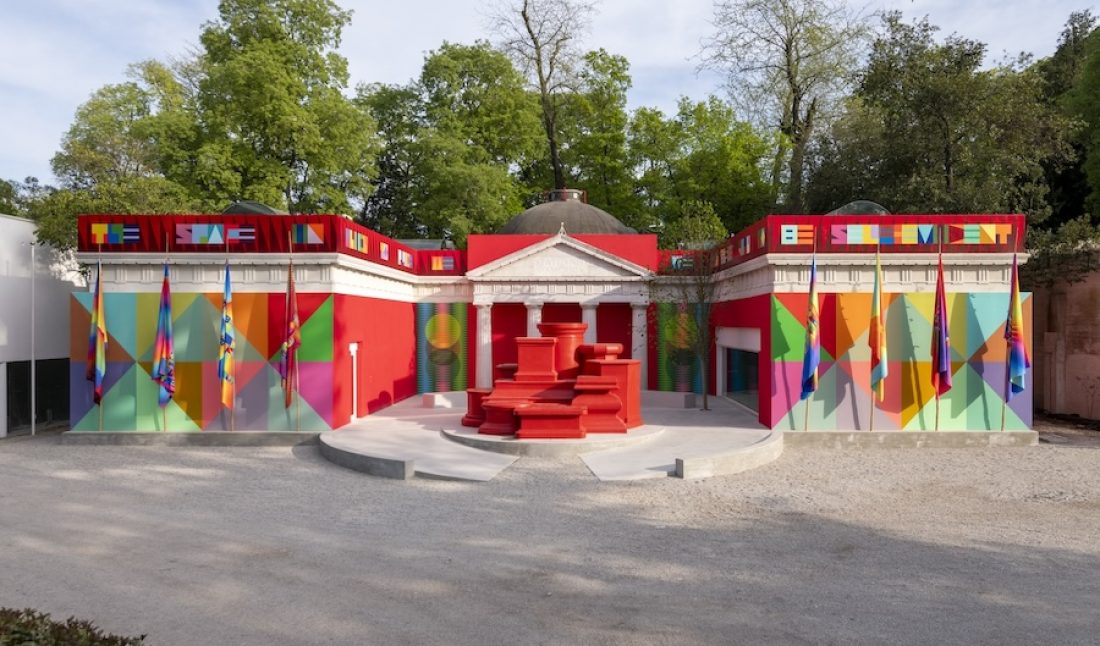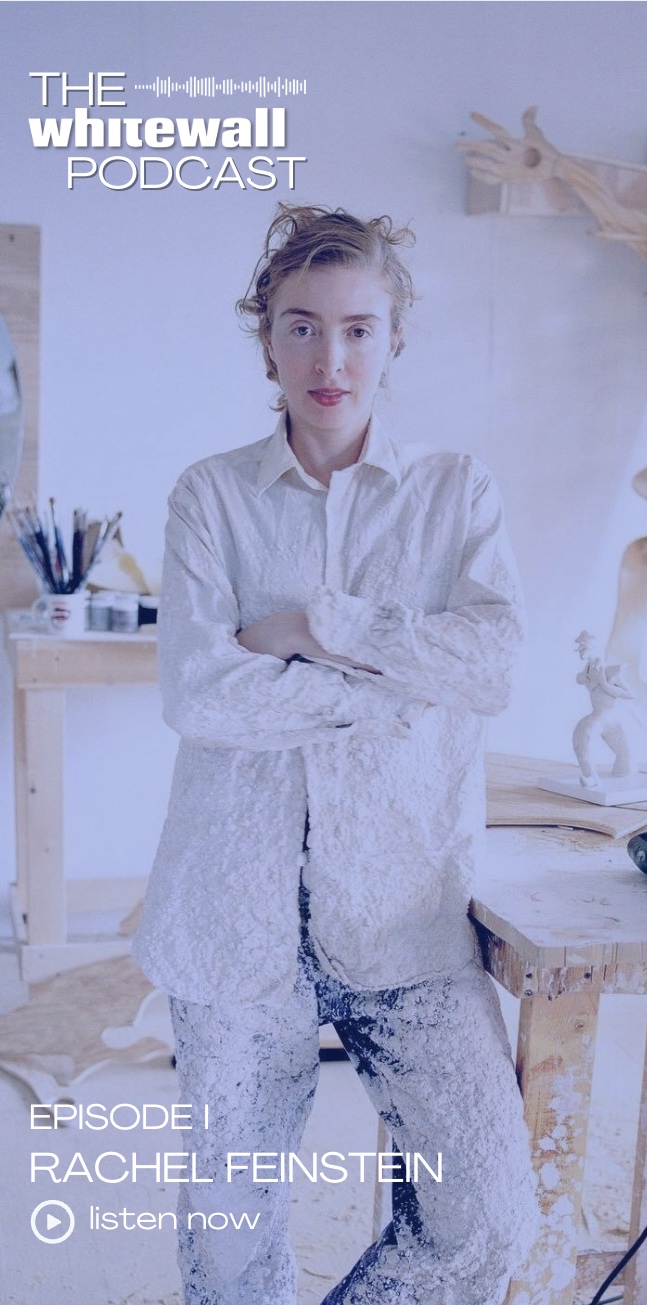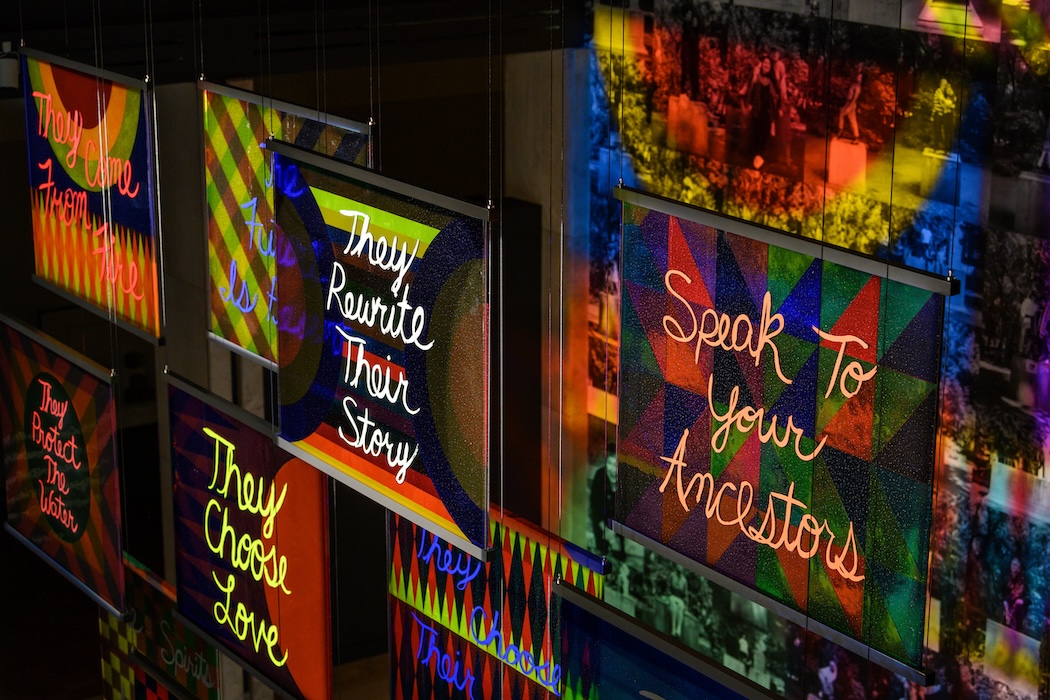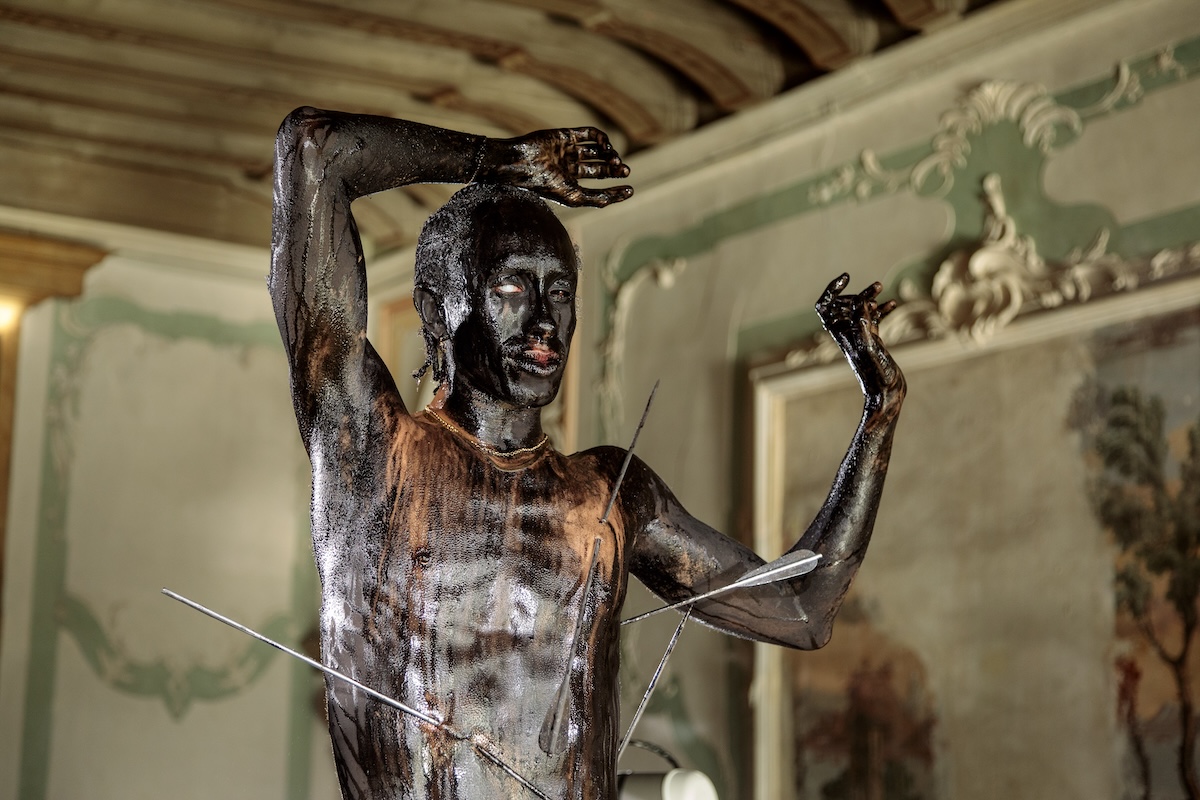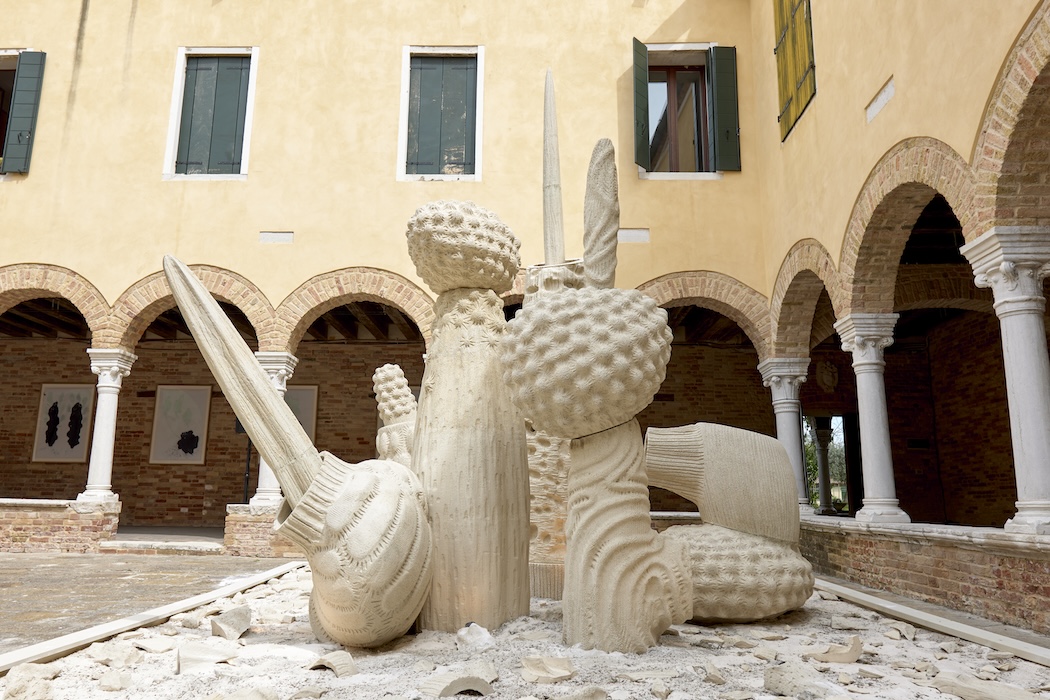At this year’s 60th Venice Biennale, Chicago-based independent curator and writer Abigail Winograd grants visitors from across the globe the extraordinary opportunity to bask in the artistry of Jeffrey Gibson—the inaugural Indigenous artist to represent the U.S. with a solo presentation at the Biennale.
Presented by Portland Art Museum and SITE Santa Fe, and commissioned by Winograd, Kathleen Ash-Milby, and Louis Grachos, “the space in which to place me” is an enveloping and prismatic tour de force of sculpture, multimedia paintings, video, and more. The Director and Chief Curator of Pueblo Unido Gallery, a student-run art space in Chicago’s North Side, has garnered a long-standing admiration of Gibson’s shimmering practice which dynamically recontextualizes the deeply felt intricacies of history and identity.
The two luminaries sparked a magnificent collaboration with the exhibition “Toward Common Cause” while Winograd served as Curator-at-large and MacArthur Fellows Program Fortieth Anniversary Exhibition Curator at the University of Chicago’s Gray Center for the Arts and Inquiry. Included in the presentation of 29 artists was Gibson’s ever-powerful Sweet Bitter Love (2021-2022), a visceral meditation on the representation of Indigenous people in cultural institutions. From that moment, a fruitful and enlightening friendship was born between two spirited individuals determined to nourish the art world with vital, new perspectives and radiant points of entry.
Whitewall sat down with the prolific Winograd, a frequent lecturer at the University of Chicago, to reflect on partnering with Gibson to create a breakthrough platform for Indigenous artists, and stamping a space of inclusion, empathy, and love that points directly at a radically inclusive future for all.
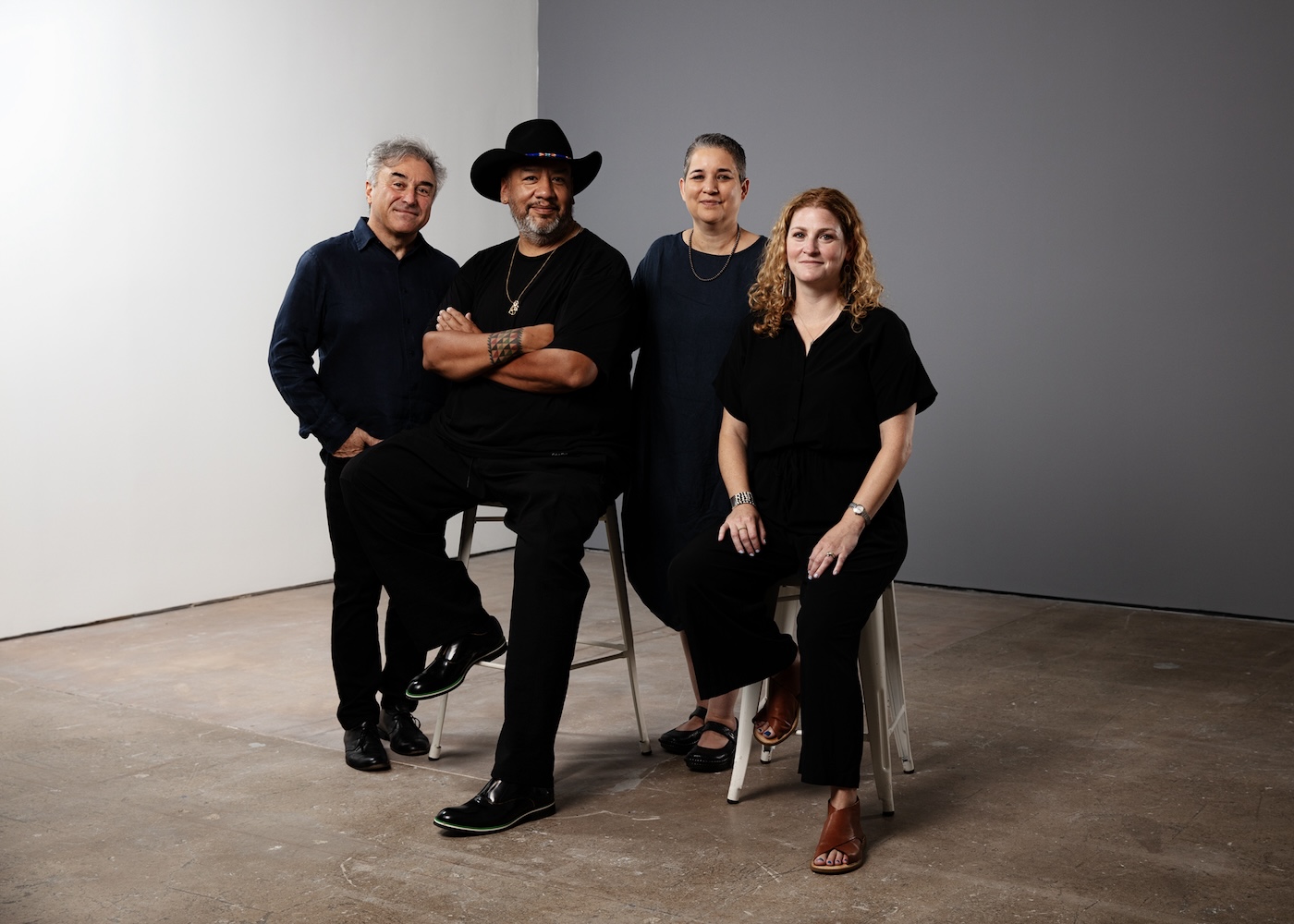 (L-R) Louis Grachos, Jeffrey Gibson, Kathleen Ash-Milby, and Abigail Winograd; photo by Cara Romero.
(L-R) Louis Grachos, Jeffrey Gibson, Kathleen Ash-Milby, and Abigail Winograd; photo by Cara Romero.
WHITEWALL: In reference to your curation of the US Pavilion with interdisciplinary artist Jeffrey Gibson, you stated, “I have long believed in the ability of Jeffrey’s work to be a force for positive change and to create the possibility of a radically inclusive future.” When did you first embark on the artist’s transformative works and what were your first impressions of his singular creative language?
ABIGAIL WINOGRAD: I had been aware of Jeffrey’s work for many years, had seen individual works, and was able to see his exhibition at the New Museum in 2019. I was intrigued by the hybridity and confidence of Jeffrey’s practice, its relationship to multiple histories, and how it was able to blend so many elements to create something truly unlike anything I’d ever seen.
I was already working on Toward Common Cause: Art, Social Change, and the MacArthur Fellows at 40 when Jeffrey was named a MacArthur Fellow in 2019. I contacted him right away and asked him to be part of the exhibition. We worked together to create an exhibition, Sweet Bitter Love, at Chicago’s Newberry Library that combined objects from their collection, a new body of work and a site-specific wallpaper by Jeffrey, and catalog cards from the Field Museum.
Our work together was rewarding and illuminating. We spent many hours discussing the state of the art world, our relationships to it, and the kind of art world we wanted to be a part of in the future. We were able to produce a book after the exhibition called Beyond the Horizon. Jeffrey’s work is a kaleidoscope that refracts and reframes the complexities of history and identity, which so often get flattened into linear or binary narratives.
“We spent many hours discussing the state of the art world, our relationships to it, and the kind of art world we wanted to be a part of in the future,” — Abigail Winograd
WW: How might Gibson be ushering in a new era of representation, inclusivity, and empathy as the inaugural Indigenous artist to represent the U.S. with a solo presentation at the 60th Venice Biennale?
AW: This is such an important and such a long-overdue moment. It is hard to believe that we are still using this kind of language in 2024. It is such an incredible thing for Jeffrey to have this distinction, the first solo Indigenous artist in the pavilion, and for him to be using this platform to support and collaborate with other Indigenous artists throughout the run of the exhibition will be transformative.
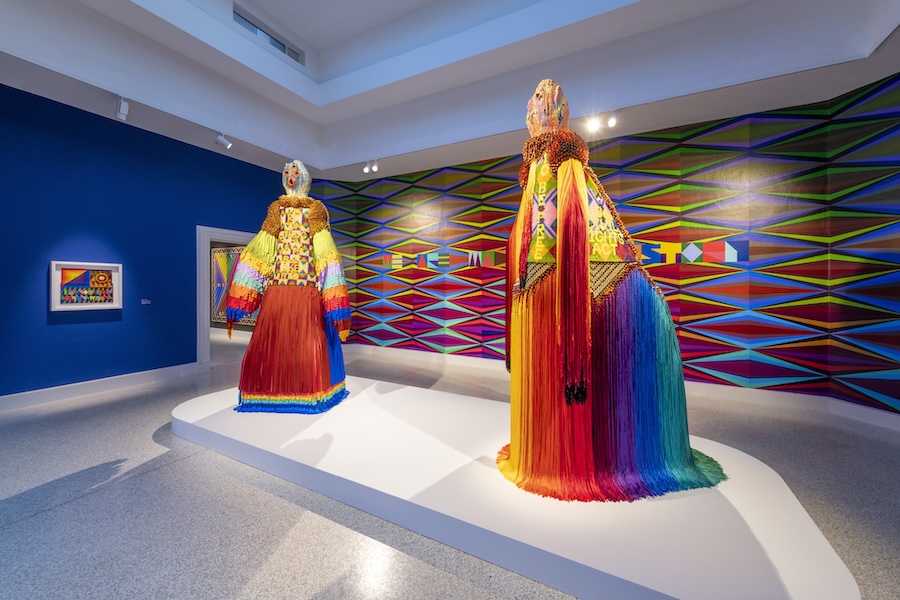 Installation view of the space in which to place me (Jeffrey Gibson’s exhibition for the United States Pavilion, 60th
International Art Exhibition – La Biennale di Venezia), April
20 – November 24, 2024; From left to right: IF NOT NOW THEN WHEN (2024); The Enforcer (2024); WE WANT TO BE FREE (2024) Mural: WE ARE MADE BY HISTORY (2024), Photo by Timothy Schenck.
Installation view of the space in which to place me (Jeffrey Gibson’s exhibition for the United States Pavilion, 60th
International Art Exhibition – La Biennale di Venezia), April
20 – November 24, 2024; From left to right: IF NOT NOW THEN WHEN (2024); The Enforcer (2024); WE WANT TO BE FREE (2024) Mural: WE ARE MADE BY HISTORY (2024), Photo by Timothy Schenck.
Building a Team to Support Jeffrey Gibson’s Kaleidoscopic Vision
WW: What was the inception of the symphonic exhibition “the space in which to place me,” which collages and uplifts Indigenous, Queer, and American historical narratives alongside music and pop culture references?
AW: I visited the Venice Biennale in 2022 and called Jeffrey from the forecourt of the US Pavilion and asked if he would be interested in submitting a proposal for the next iteration. After seeing the reaction of audiences to Jeffrey’s work and the work we had done together, I felt so strongly that Jeffrey’s vision of a radically inclusive future would be so meaningful on an international stage. It was not the first time Jeffrey had been asked to consider a submission but he felt that he was ready. He, and I, very intentionally built a team that could support his vision.
Pushing Against Persistent Stereotypes and Challenging Preconceptions
WW: The enigmatic title of the show pays respect to Oglala Lakota poet Layli Long Soldier’s captivating poem Ȟe Sápa. How was the artist energized by this particular work at this moment in history?
AW: Creating a proposal for the pavilion required Jeffrey to think about what it meant for his work to take up residence in the US Pavilion. His work draws inspiration from his own intersectional identity as a queer, Indigenous man and pushes against persistent stereotypes of Native and queer people but also anyone that exists outside of a “normative” American identity.
Layli’s uses language to create a visual space on the page that requires the reader to change their perspective to complete their reading. Jeffrey’s exhibition is likewise challenging preconceptions and asking visitors to rethink the way they see themselves and others.
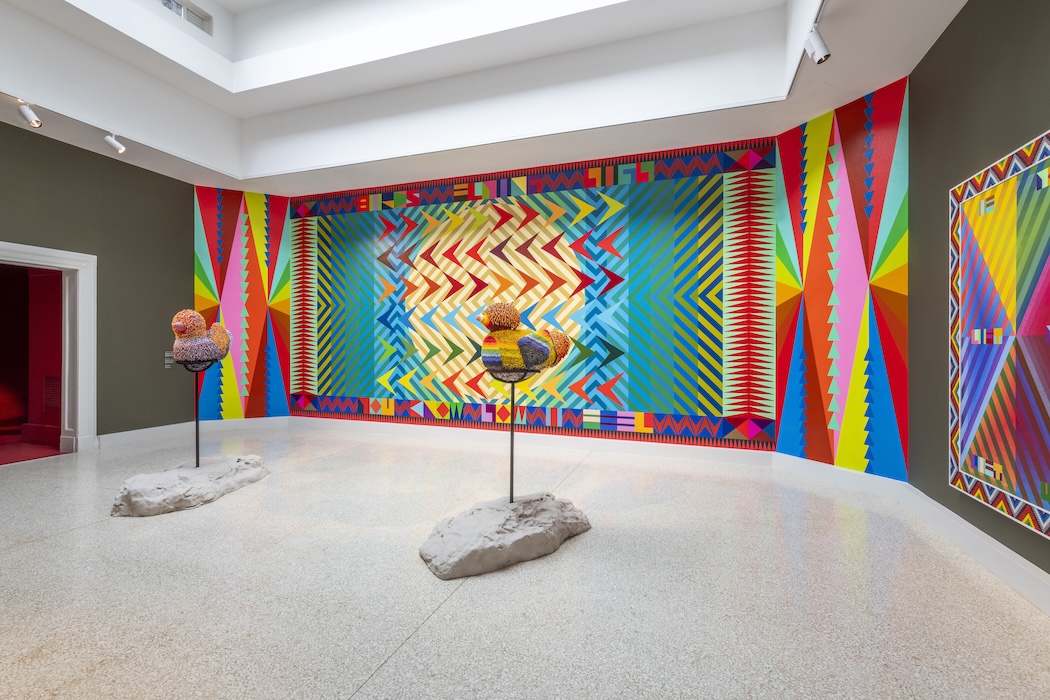 Installation view of the space in which to place me (Jeffrey
Gibson’s exhibition for the United States Pavilion, 60th
International Art Exhibition – La Biennale di Venezia), April
20 – November 24, 2024; Birds from left to right: we are the witnesses (2024); if there
is no struggle there is no progress (2024).
Wall works from left to right: BIRDS FLYING HIGH YOU KNOW HOW I FEEL (2024); IF YOU WANT TO LIFT YOURSELF UP LIFT UP SOMEONE ELSE (2024);
Photo by Timothy Schenck.
Installation view of the space in which to place me (Jeffrey
Gibson’s exhibition for the United States Pavilion, 60th
International Art Exhibition – La Biennale di Venezia), April
20 – November 24, 2024; Birds from left to right: we are the witnesses (2024); if there
is no struggle there is no progress (2024).
Wall works from left to right: BIRDS FLYING HIGH YOU KNOW HOW I FEEL (2024); IF YOU WANT TO LIFT YOURSELF UP LIFT UP SOMEONE ELSE (2024);
Photo by Timothy Schenck.
Traditions of Native American Adornment Meet Andy Warhol’s Artistry
WW: What informs Gibson’s visceral use of color, pattern, and texture, and how does it spark an experiential journey for visitors of all ages to meditate on a mosaic of relationships, identities, and freedoms?
AW: Jeffrey draws on a broad range of source material for his work. From Indigenous weaving, regalia and traditions of Native American adornment to Sister Corita Kent and Andy Warhol. He is able to seamlessly blend textile, beadwork, painting, sculpture, video, and performance into total environments. His use of text draws from poetry, music, and, in the case of the pavilion, legislative documents. This intersectionality mirrors the fluidity of his own experience as a Queer, Indigenous person and acknowledges the multiplicity, hybridity, and exchange that defines contemporary life. This diversity of references means there is always a point of entry for audiences, a way for them to place themselves or see themselves in the work.
“This diversity of references means there is always a point of entry for audiences, a way for them to place themselves or see themselves in the work,” — Abigail Winograd
WW: Can you illuminate the remarkable ways in which the exhibition invokes two momentous decades of Gibson’s artistic, social, and cultural exploration?
AW: The exhibition combines all the elements of Jeffrey’s practice in one exhibition. What is remarkable about Jeffrey’s work is his ability to bring together so many different elements including color, pattern, language, beads, textile, paint, found objects, etc. together to create balanced, harmonious compositions. He has extended this ability in the pavilion to create a completely immersive experience.
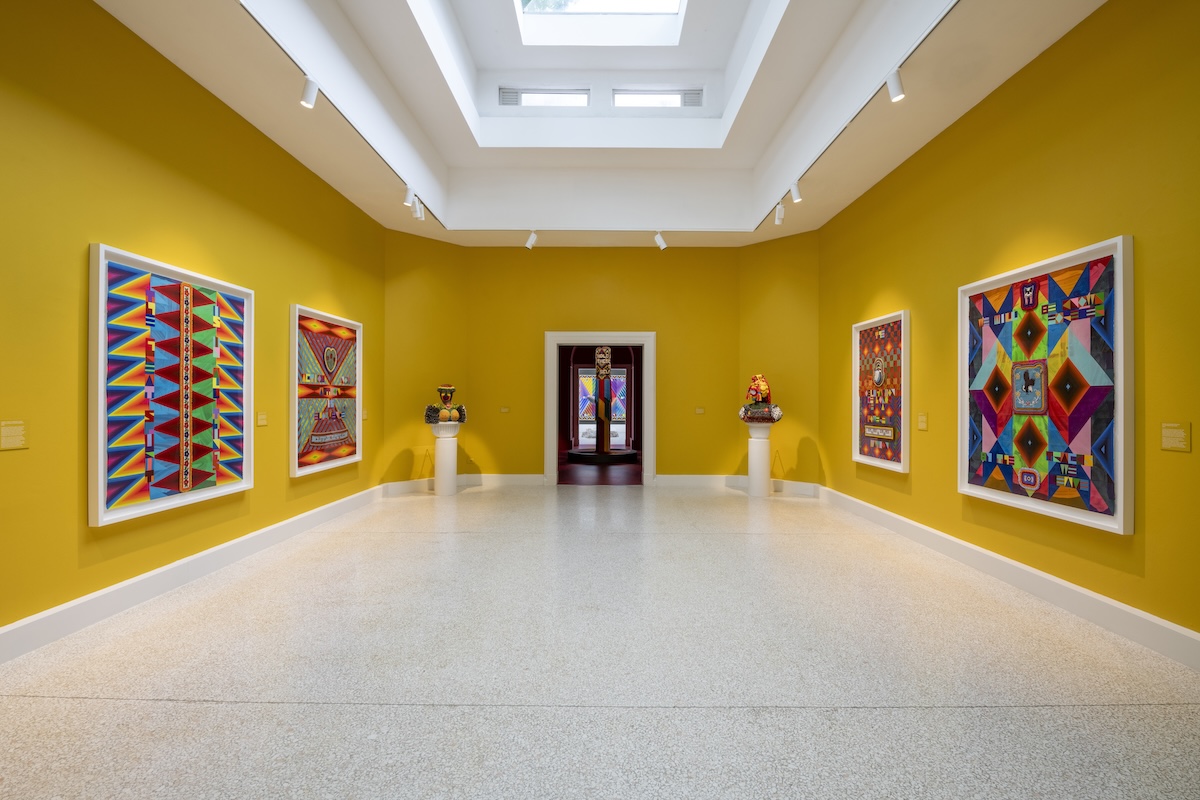 Installation view of the space in which to place me (Jeffrey
Gibson’s exhibition for the United States Pavilion, 60th
International Art Exhibition – La Biennale di Venezia), April
20 – November 24, 2024; THE GREAT SPIRIT IS IN ALL THINGS (2024); ACTION NOW
ACTION IS ELOQUENCE (2024); THE OBLIGATION OF HONOR
OF A POWERFUL NATION (2024); WE WILL BE KNOWN
FOREVER BY THE TRACKS WE LEAVE (2024); Busts from left to right: Be Some Body (2024); I’M A NATURAL MAN (2024), Photo by Timothy Schenck.
Installation view of the space in which to place me (Jeffrey
Gibson’s exhibition for the United States Pavilion, 60th
International Art Exhibition – La Biennale di Venezia), April
20 – November 24, 2024; THE GREAT SPIRIT IS IN ALL THINGS (2024); ACTION NOW
ACTION IS ELOQUENCE (2024); THE OBLIGATION OF HONOR
OF A POWERFUL NATION (2024); WE WILL BE KNOWN
FOREVER BY THE TRACKS WE LEAVE (2024); Busts from left to right: Be Some Body (2024); I’M A NATURAL MAN (2024), Photo by Timothy Schenck.
A Harmonious Transformation of the Pavilion Unfolds in Venice
WW: How does the dramatic exterior and interior design of the Pavilion echo this evolving and poetic exploration?
AW: Jeffrey‘s work with the pavilion’s exterior is part of his complete transformation of the building. It reflects his engagement with classical Greek and Roman architecture and his relationship to canonical art histories. I’ve actually been struck as we are installing by how harmonious the pavilion and all the work in it has become.
History has long associated Palladian architecture, with little to no color and adornment, with democracy, and by extension, democracy with white/maleness. We know that Greek and Roman architecture and sculpture were heavily painted and adorned, so the association of color, pattern, and adornment with “otherness” is an historical fallacy that Jeffrey refutes. This is totally in keeping with Jeffrey’s effort and ability to reframe what we know. The Pavilion, with Jeffrey’s intervention, has more in common with what a classical building would ACTUALLY have looked like.
Jeffrey, all Indigenous artists, all queer artists, anyone who’s practice has been maligned as being too kitschy or too camp, are not outside of history. They have every right to be here. Jeffrey’s pavilion marks a space of inclusion and empathy and love, just like all of his work.
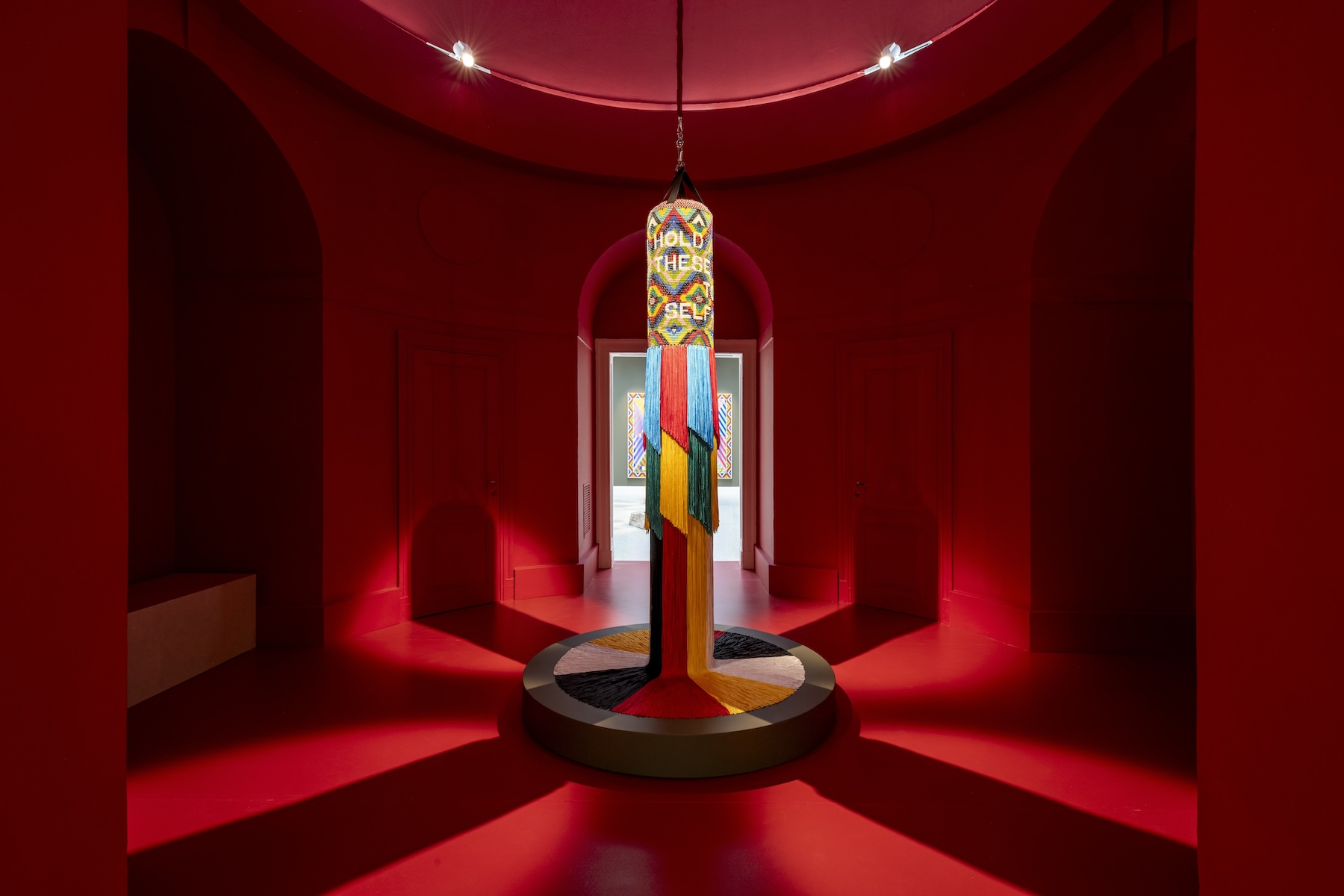 Installation view of the space in which to place me (Jeffrey
Gibson’s exhibition for the United States Pavilion, 60th
International Art Exhibition – La Biennale di Venezia), April
20 – November 24, 2024;
Center: WE HOLD THESE TRUTHS TO BE SELF-EVIDENT (2024); Photo by Timothy Schenck.
Installation view of the space in which to place me (Jeffrey
Gibson’s exhibition for the United States Pavilion, 60th
International Art Exhibition – La Biennale di Venezia), April
20 – November 24, 2024;
Center: WE HOLD THESE TRUTHS TO BE SELF-EVIDENT (2024); Photo by Timothy Schenck.
Native Artists Perform Together, For Themselves and Their Communities
WW: Upon opening day, a dance program on-site will feature rapturous performances by the Colorado Intertribal Dancers and Oklahoma Fancy Dancers. How do you expect visitors will react to this immersive and celebratory event?
AW: I hope they understand how unique it is to see Native artists performing together, for themselves, for their communities and how that agency, that act of self-representation, challenges the exploitative histories of the past. This is a declarative and emphatic moment for the dancers, the poets, the musicians, to represent themselves and celebrate together. The Jingle Dance is rooted in ceremony and is meant to bring healing. I hope audiences understand how momentous that is and that they all receive some of that grace.
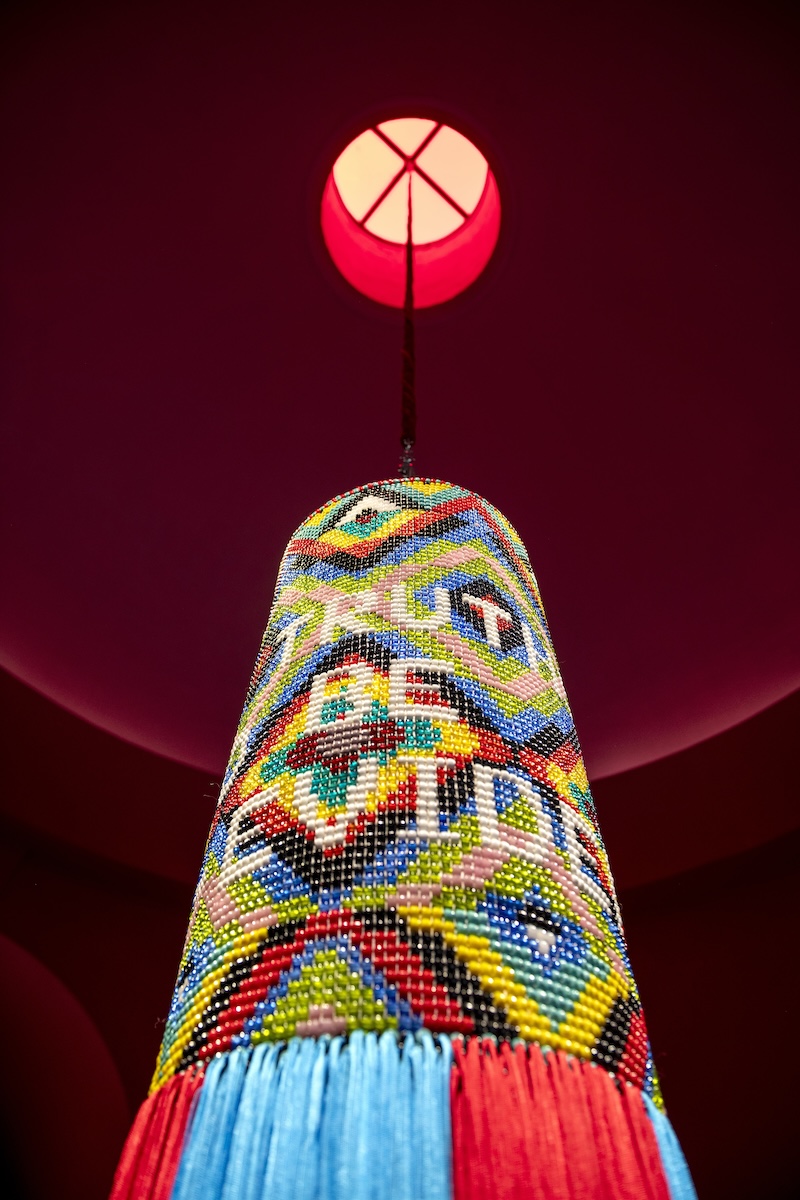 Installation view of the space in which to place me (Jeffrey
Gibson’s exhibition for the United States Pavilion, 60th
International Art Exhibition – La Biennale di Venezia), April
20 – November 24, 2024;
Center: WE HOLD THESE TRUTHS TO BE SELF-EVIDENT (2024); Photo by Timothy Schenck.
Installation view of the space in which to place me (Jeffrey
Gibson’s exhibition for the United States Pavilion, 60th
International Art Exhibition – La Biennale di Venezia), April
20 – November 24, 2024;
Center: WE HOLD THESE TRUTHS TO BE SELF-EVIDENT (2024); Photo by Timothy Schenck.
Believing in the Ability of Art to Make a Positive Change in the World
WW: You also stated in regards to this much-anticipated exhibition, “It is my hope that as a global audience experiences his work through the Biennale, they will also find it to be a source of joy and healing, something sorely needed in a world driven by conflict and crisis.” How have you personally found this project to be a restorative and invigorating collaboration?
AW: Jeffrey and I believe in the ability of art to make positive change in the world. I have seen the way Jeffrey’s work impacts people on a personal level. In this moment, I believe an encounter with Jeffrey’s work has the ability to change the way people envision our collective future . . . one filled with joy and possibility. I am so grateful for the opportunity to continue collaborating with Jeffrey and so unbelievably excited for the world to experience this project. I hope they find it meaningful and transformative. I am certain it will be unlike what anyone has ever seen in the pavilion or at the Biennale.







